Connected Medical Devices Market Size
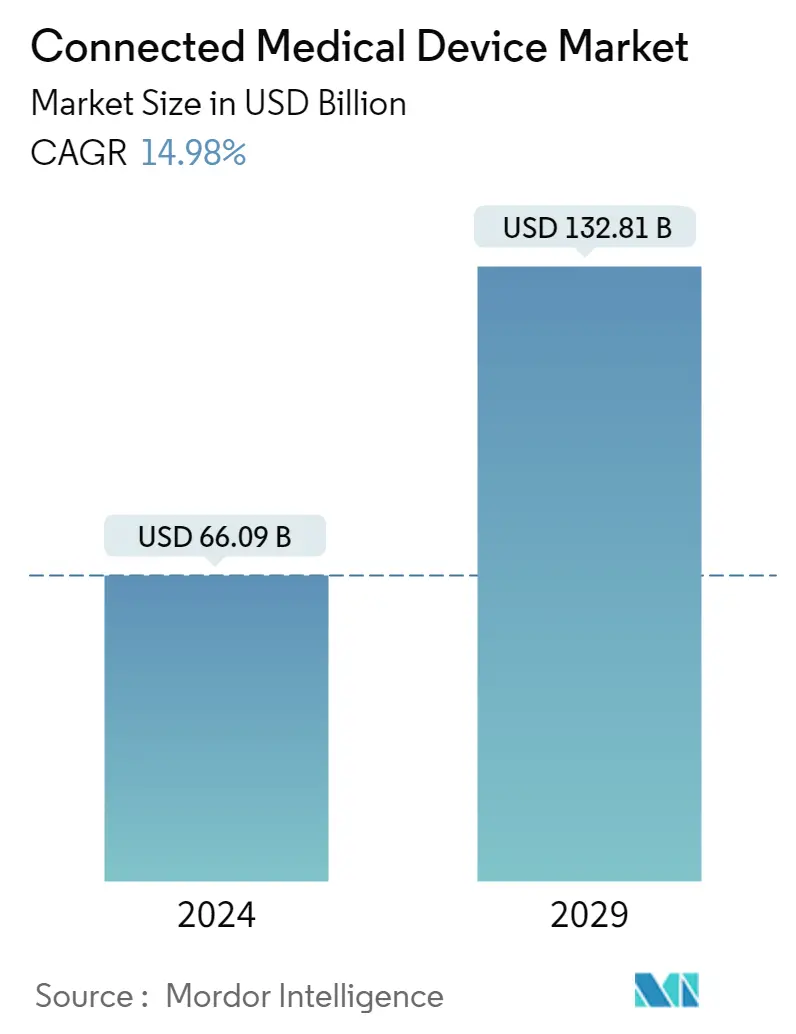
| Study Period | 2019 - 2029 |
| Market Size (2024) | USD 66.09 Billion |
| Market Size (2029) | USD 132.81 Billion |
| CAGR (2024 - 2029) | 14.98 % |
| Fastest Growing Market | Asia Pacific |
| Largest Market | North America |
Major Players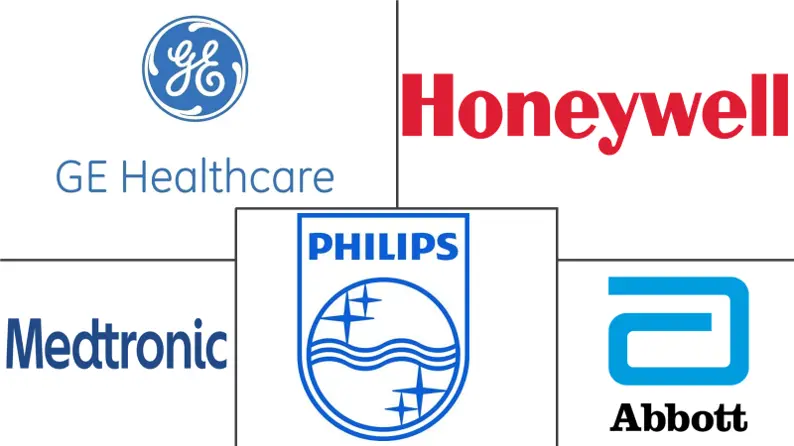
*Disclaimer: Major Players sorted in no particular order |
Need a report that reflects how COVID-19 has impacted this market and its growth?
Connected Medical Devices Market Analysis
The Connected Medical Device Market size is estimated at USD 66.09 billion in 2024, and is expected to reach USD 132.81 billion by 2029, growing at a CAGR of 14.98% during the forecast period (2024-2029).
The medical facilities and the medical research sector use the Internet of Things (IoT) and advancements in computing power, wireless technology, and data analytics techniques, like Big Data. They use it to analyze a large amount of complex heterogeneous medical data involving genomics, proteomics, and pharmacogenomics, which have significantly transformed the healthcare industry over the last few years.
- The market for connected medical devices is one of those new medical industries that has consistently grown over the last decade, given its dependency on IoT technologies. In the world of connected medical devices, opportunities for technological integration exist throughout the device's lifecycle, from manufacturing and maintenance to use. For over two decades, consumer-facing healthcare has steadfastly resisted the wave of innovations that have been disrupting industries. It signifies that the industry is ripe for disruption, and technologies like Artificial Intelligence (AI) and Machine Learning (ML) will be vital to unlocking greater connected healthcare possibilities.
- As per the Center for Medicare and Medicaid Services, last year, the National Healthcare Expenditure grew 9.7% to USD 4.1 trillion in 2020 or USD 12,530 per person. It accounted for 19.7% of the Gross Domestic Product (GDP) in the United States. The total National health expenditure is estimated to expand at an average annual rate of 5.4% for 2019-28 and will reach a landmark of USD 6.2 trillion by 2028. Such drastic expenditure on healthcare signifies a possible gradual overall increment in the requirement for connected devices.
- Also, according to the US Center for Disease and Prevention report, the overall life expectancy at birth is steadily rising, with the aim of 74.4 years by the current year, up from 73.3 years in 2017. Most of the increase is because of the lower infant mortality. However, according to the same survey, life expectancy in the U. S. has dropped for the third year consecutively to 78.6 years. People mainly strive toward a healthy lifestyle to keep fit and monitor their eating habits. Such changes in people's behavior would significantly increase the demand for connected medical devices.
- The total cost of connectivity and interoperability solutions for various medical equipment is incredibly high. Internet access to medical equipment is difficult to adopt in smaller healthcare organizations because creating multiple networks with secure configurations is challenging. There are few wireless connectivity alternatives, and they must add numerous security layers to prevent data breaches. This challenge raises the overall cost of ownership for healthcare providers even more.
- The COVID-19 pandemic has highly increased the use of healthcare-connected devices for remote patient monitoring while keeping patients and medical personnel safe from one another. In this pandemic, healthcare personnel and systems have highly relied on technology to deliver the required care to patients at their homes through telecommunication and remote patient monitoring programs. Similarly, government health officials have utilized technology to restrict the spread of the virus, using smartphone-based contact tracking and proactive wellness monitoring or tele-consultancies. People's emphasis has shifted to self-care facilities in their homes due to the COVID-19 pandemic.
Connected Medical Devices Market Trends
This section covers the major market trends shaping the Connected Medical Device Market according to our research experts:
Wearable Device is Expected to Hold a Major Share
- In healthcare, wearable devices offer practical ways to monitor various physiological parameters. Medical solutions do not just benefit customers. They also give doctors up-to-date information to examine patients from a distance. The healthcare industry has a wide range of uses for wearable medical devices, starting from the Apple Watch's EKG capabilities to its glucose monitoring systems.
- Also this year, Apple Inc introduced Apple Watch Series 8 in India, offering the ECG app and several features related to women's health. The watch provided ovulation estimates leveraging a two-sensor temperature sensing technology. The new crash detection was also helpful in forming emergency contacts or nearby facilities in case a crash was detected, which could be highly crucial during fatal encounters. Such devices develop the ecosystem for innovative and thoughtful additions to existing and upcoming medical and everyday wearables.
- In addition to being practical, wearable technology is also economical since the data it produces may allow doctors to make choices from a distance, reducing the number of hospital visits by patients for routine checkups. Moreover, health-related wearables go beyond fitness bands. The vast and expanding healthcare wearable market includes various products, including smartwatches, smart glasses, smart footwear, smart clothes, posture monitors, pain management devices, movement sensors, wrist devices, heart straps, headbands, wearable patches, and medicine delivery pods.
- Disease diagnostics and patient treatment monitoring are about to revolutionize due to mobile technology advancements. You can use wearables as a clinical tool to identify the patterns of a particular disease, provide a better understanding of the disease, and continuously monitor users' health since they are personal gadgets that continuously monitor critical indicators. For instance, FitBit and smartwatches are popular due to how wearable fitness technology has risen into society, introducing exercise-specific modes and customizable features. Over the forecasted period, wearable technology will continue to expand.
- Per Cisco Systems, globally, the number of connected wearable devices has increased from 325 million in 2016 to 722 million in 2019, doubling in only three years. More than one billion gadgets will likely be worldwide by the current year.
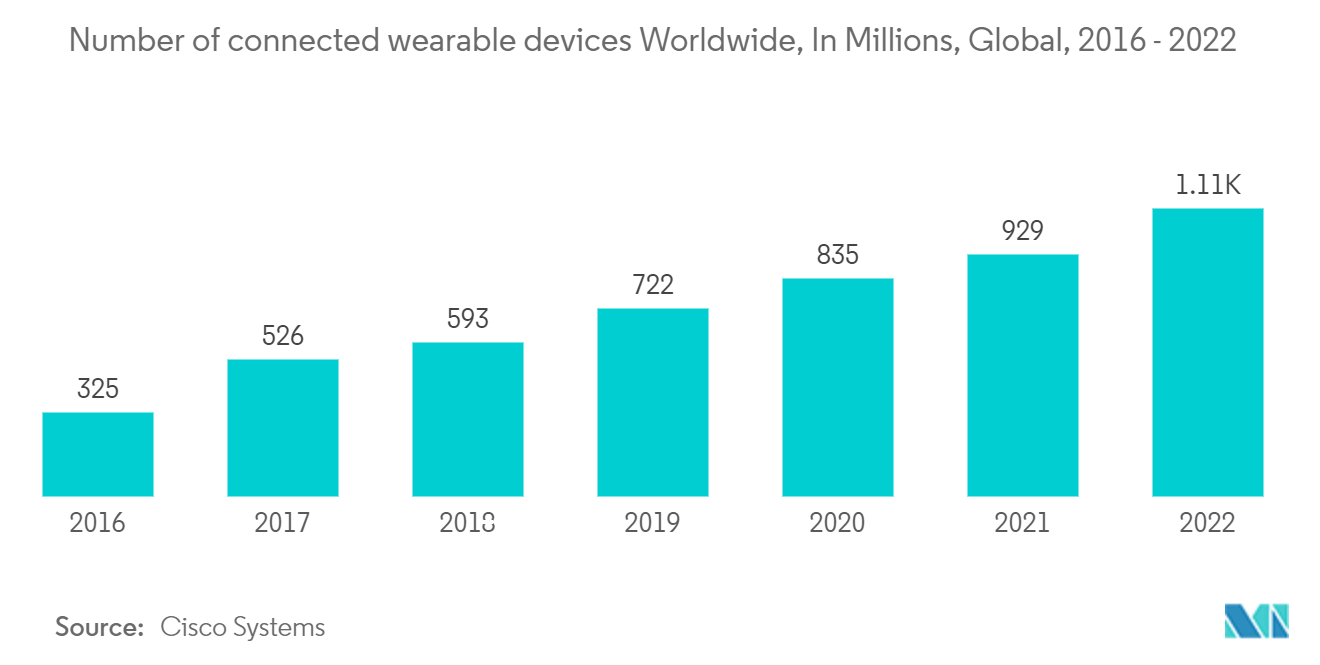
North America Holds the Highest Market Share
- The presence of well-established medical device manufacturers, an advanced healthcare infrastructure, expansions, and considerable healthcare spending characterize the US-connected medical device industry. For instance, in December last year, RAYUS Radiology opened a new outpatient-based advanced diagnostic imaging center in Auburn, expanding its operations of imaging clinics around Maine. High-field MRI, CT, and X-ray are just a few diagnostic imaging services the center in Auburn provides.
- Additionally, the FDA authorized the use of Epitel's initial device, a wireless and wearable EEG (brain wave monitor) sensor, in hospital emergency rooms and critical care units last year. Epitel's first FDA-approved product included wearable, wireless sensors, which a nurse or hospital technician could easily and quickly apply. Neurologists could also evaluate and keep an eye out for seizures by connecting the EEG data to a cloud-based software platform they could access from anywhere at any time. Also, in February this year, the company raised USD 12.5 million in a Series A funding round for its wearable seizure detection system.
- Other smart wearable manufacturers are exploring the medical wearables space in the country by introducing innovative solutions which ease data collection through connected app features. In September year, Garmin launched a smart blood pressure monitor, 'Index BPM,' for USD 150, allowing users to measure diastolic and systolic blood pressure anywhere. The FDA-approved upper arm BPM could keep the individual records of up to 16 users and sync the data to their own Garmin Connect app.
- Medical devices, like other computer systems, are susceptible to security flaws, which could jeopardize the device's effectiveness and safety. When there is a reasonable assurance that the benefits to patients and individuals outweigh the dangers, the FDA permits the marketing of devices.
- According to Synopsys, a company that designed computer-integrated systems, the average number of connected medical devices per bed in US hospitals is 10-15. The certification procedure for wireless devices is crucial for businesses looking to bring connected devices to the market. All wireless devices must undergo this testing, separate from that conducted by the FDA in North America. Hence the rise in the total count of connected medical devices in the US would bring immense growth opportunities to the market throughout the forecasted period.
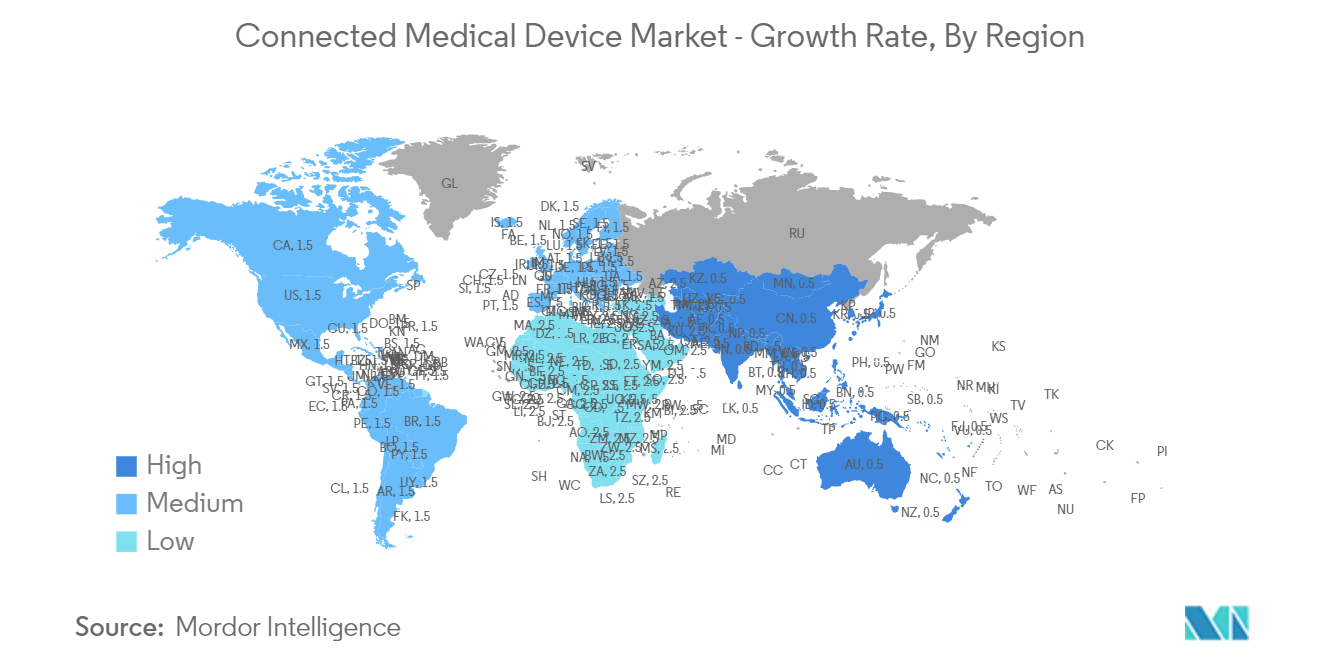
Connected Medical Devices Industry Overview
The Connected Medical Device Market mainly comprises multiple domestic and international players in a fragmented and highly competitive environment. Technological enhancements in the market also bring companies a wide range of sustainable competitive advantages. The market is also witnessing multiple partnerships, mergers, and other strategic moves by the service providers.
October 2022 - Royal Philips announced the expanded introduction of its augmented reality (AR) surgical navigation solution, ClarifEye, in Japan. It is based on the positive results in the initial patients treated at the IUHW (International University of Health and Welfare), Mita Hospital (in Tokyo, Japan) leveraging the innovative 3D AR solution. ClarifEye assisted the hospital's orthopedic surgeon, Dr. Ken Ishii, in successfully treating patients with scoliosis (sideways curvature of the spine) and spinal stenosis (narrowing of the spaces in the spine) through minimally-invasive image-guided procedures.
June 2022 - GE Healthcare unveiled Portrait Mobile3, a wireless patient monitoring system that enabled continuous monitoring throughout a patient's stay, omitting broadly popular manual 'spot-checks' to monitor patient vitals. The system helped clinicians detect patient deterioration. The early detection of patient deterioration might help reduce Intensive Care Unit (ICU) admissions and length of stay, improving patient outcomes. The solution included patient-worn wireless sensors which communicated with a mobile monitor.
Connected Medical Devices Market Leaders
https://www.gehealthcare.com/
https://www.honeywell.com/us/en
https://www.medtronic.com/us-en/index.html
https://www.abbott.com/
https://www.philips.com/global
*Disclaimer: Major Players sorted in no particular order
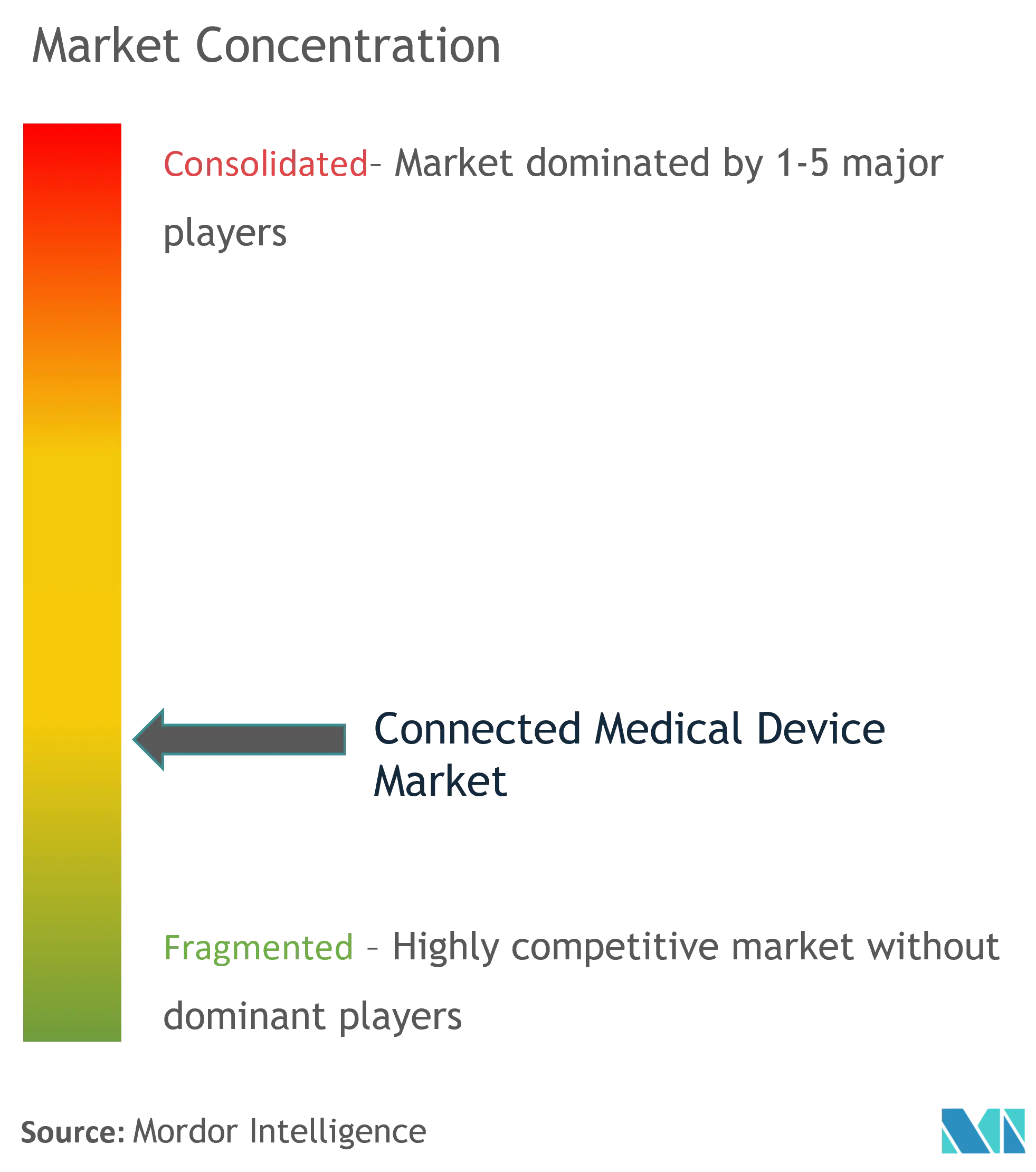
Connected Medical Devices Market News
- August 2022 - Medtronic plc declared entering a strategic partnership with BioIntelliSense, a continuous health monitoring and clinical intelligence company, for the US hospitals only and 30-day post-acute hospital-to-home distribution rights of the BioButton multi-parameter wearable for straight, connected monitoring. The partnership allowed the Medtronic Patient Monitoring business to access a medical-grade device that primarily offered continuous vital sign measurements of general care patients in-hospital and post-discharge.
- March 2022 - Microsoft Corp. declared updates to Microsoft Cloud for Healthcare and developments in cloud technologies for life sciences and healthcare with the general availabilities of its Azure Health Data Services. With the recent acquisition of Nuance Communications, Microsoft accelerates an organization's ability to assist others by leveraging trusted AI to address the most significant challenges transforming the future of healthcare.
- January 2022 - Abbott announced the development of a new consumer bio wearable, Lingo, primarily built to detect critical body signals, like ketones, glucose, and lactate, helping people better understand their general health and take the required action.
Connected Medical Devices Market Report - Table of Contents
1. INTRODUCTION
1.1 Study Assumptions and Market Definition
1.2 Scope of the Study
2. RESEARCH METHODOLOGY
3. EXECUTIVE SUMMARY
4. MARKET INSIGHTS
4.1 Market Overview
4.2 Industry Value Chain Analysis
4.3 Industry Attractiveness - Porter's Five Forces Analysis
4.3.1 Bargaining Power of Suppliers
4.3.2 Bargaining Power of Buyers/Consumers
4.3.3 Threat of New Entrants
4.3.4 Threat of Substitute Products
4.3.5 Intensity of Competitive Rivalry
4.4 Assessment of the Impact of COVID-19 on the Industry
5. MARKET DYNAMICS
5.1 Market Drivers
5.1.1 Increase in the Adoption of Data Analytics in the Healthcare Sector
5.1.2 Reduction of the Total Cost of Sensing Devices
5.2 Market Challenges
5.2.1 Legacy Infrastructure Challenging the Digital Growth
6. CONNECTIVITY TECHNOLOGIES
6.1 Wi-Fi
6.2 Bluetooth Low Energy (BLE)
6.3 Near-field Communication (NFC)
6.4 Zigbee
6.5 Cellular
7. MARKET SEGMENTATION
7.1 Application
7.1.1 Consumer (Patient) Monitoring
7.1.2 Wearable Device
7.1.3 Internally Embedded Device
7.1.4 Stationary Device
7.2 Geography
7.2.1 North America
7.2.1.1 United States
7.2.1.2 Canada
7.2.2 Europe
7.2.2.1 Germany
7.2.2.2 United Kingdom
7.2.2.3 France
7.2.2.4 Rest of Europe
7.2.3 Asia-Pacific
7.2.3.1 China
7.2.3.2 Japan
7.2.3.3 South Korea
7.2.3.4 Rest of Asia-Pacific
7.2.4 Latin America
7.2.5 Middle East and Africa
8. COMPETITIVE LANDSCAPE
8.1 Company Profiles
8.1.1 Medtronic Inc.
8.1.2 Koninklijke Philips NV
8.1.3 Boston Scientific Corporation
8.1.4 Abbott Laboratories
8.1.5 Garmin Ltd
8.1.6 Biotronik Se & Co. Kg
8.1.7 Honeywell International Inc.
8.1.8 Stanley Healthcare
8.1.9 NXP Semiconductors NV
8.1.10 GE Healthcare
- *List Not Exhaustive
9. INVESTMENT ANALYSIS
10. MARKET OPPORTUNITIES AND FUTURE TRENDS
Connected Medical Devices Industry Segmentation
The Internet of Medical Things enables medical devices to connect to the cloud and applications. Connected medical devices can also offer various portable diagnostic tools that can be well utilized for in-home collection and diagnosis. This connectivity could imply the benefit directly for both patients and healthcare service companies.
The connected medical device market is segmented by application (consumer (patient) monitoring, wearable devices, internally embedded devices, and stationary devices) and geography (North America, Europe, Asia-Pacific, Latin America, and Middle East and Africa). The market sizes and forecasts are present in value (USD million) for all the above segments.
| Application | |
| Consumer (Patient) Monitoring | |
| Wearable Device | |
| Internally Embedded Device | |
| Stationary Device |
| Geography | ||||||
| ||||||
| ||||||
| ||||||
| Latin America | ||||||
| Middle East and Africa |
Connected Medical Devices Market Research FAQs
How big is the Connected Medical Device Market?
The Connected Medical Device Market size is expected to reach USD 66.09 billion in 2024 and grow at a CAGR of 14.98% to reach USD 132.81 billion by 2029.
What is the current Connected Medical Device Market size?
In 2024, the Connected Medical Device Market size is expected to reach USD 66.09 billion.
Who are the key players in Connected Medical Device Market?
https://www.gehealthcare.com/, https://www.honeywell.com/us/en, https://www.medtronic.com/us-en/index.html, https://www.abbott.com/ and https://www.philips.com/global are the major companies operating in the Connected Medical Device Market.
Which is the fastest growing region in Connected Medical Device Market?
Asia Pacific is estimated to grow at the highest CAGR over the forecast period (2024-2029).
Which region has the biggest share in Connected Medical Device Market?
In 2024, the North America accounts for the largest market share in Connected Medical Device Market.
What years does this Connected Medical Device Market cover, and what was the market size in 2023?
In 2023, the Connected Medical Device Market size was estimated at USD 57.48 billion. The report covers the Connected Medical Device Market historical market size for years: 2019, 2020, 2021, 2022 and 2023. The report also forecasts the Connected Medical Device Market size for years: 2024, 2025, 2026, 2027, 2028 and 2029.
Connected Medical Devices Industry Report
Statistics for the 2024 Connected Medical Devices market share, size and revenue growth rate, created by Mordor Intelligence™ Industry Reports. Connected Medical Devices analysis includes a market forecast outlook to 2029 and historical overview. Get a sample of this industry analysis as a free report PDF download.
